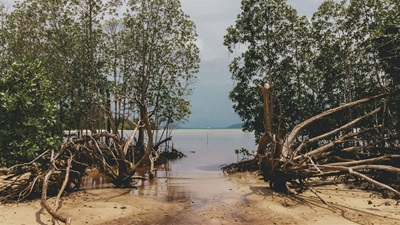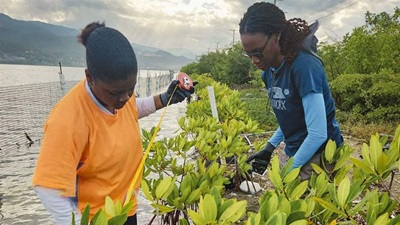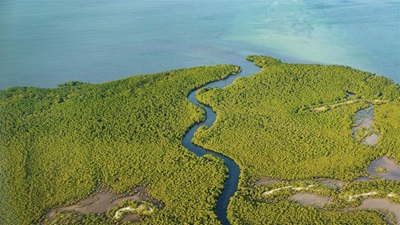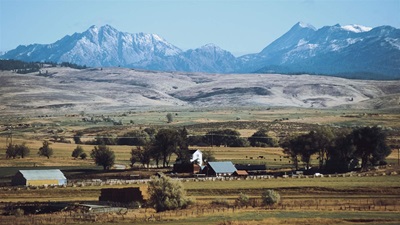How Climate Commitments Can Strengthen Coastal Communities
Mangroves, seagrasses, and salt marshes can be powerful allies for people and nature—if countries include them in their Paris Agreement pledges

The pledges that countries make to meet the goals of international climate treaties—such as the nationally determined contributions, or NDCs, governments submit under the landmark 2015 Paris Agreement—often directly affect people’s lives, for example by influencing job markets, energy costs, and air quality and how floods, storms, and other severe weather events affect communities.
With the United Nations Climate Change Conference (COP30) convening in Belém, Brazil, beginning Nov. 10, these commitments take on renewed urgency. As they do every five years, parties to the Paris Agreement are obligated to submit updated NDCs this year (many have done so, but several others haven’t yet).
What are NDCs?
Nationally determined contributions are the cornerstone of the Paris Agreement—the legally binding international treaty adopted in 2015 by nearly 200 countries to strengthen the global response to climate change. Think of NDCs as each nation’s customized roadmap for reducing emissions and adapting to climate impacts, tailored to that country’s circumstances and capabilities—roadmaps that include not only industrial sectors, but nature-based solutions such as the conservation of “blue carbon” coastal wetland ecosystems.
Importantly, the Paris Agreement requires countries to steadily raise the ambitions of their NDCs over time, with each update reflecting greater ambition than the last. This is based on the understanding that the science, tools, and capabilities, including climate finance, available to meet NDC targets would expand and mature over time. NDCs are also shaped by the periodic Global Stocktake and Biennial Transparency Report Review processes of the United Nations Framework Convention on Climate Change, which offer opportunities for governments to assess the scale of progress, or lack thereof, and tailor their targets accordingly.
The blue carbon ecosystem opportunity
Restoring and protecting carbon-storing natural habitats is among the best climate mitigation solutions humankind could pursue right now, second only to directly reducing greenhouse gas emissions. Three coastal wetland ecosystems—mangroves, seagrasses, and salt marshes—are particularly valuable in this regard because of the enormous amounts of carbon these ecosystems sequester.
These blue carbon ecosystems—so named because they’re on the fringe of marine waters— also blunt the impacts of storm surge, sea-level rise, and coastal erosion, thus making adjacent communities more resilient to severe weather.
And these benefits in reducing emissions and adapting to a changing climate come from some of the most biodiverse and productive ecosystems on the planet: One-fifth of the world’s fisheries depend on seagrass ecosystems alone. Yet the sheer breadth of benefits that coastal wetlands provide also often creates the kind of competing priorities that can drive poorly coordinated development and a lack of engagement with many of the stakeholders that rely on these ecosystems for their homes and livelihoods.
This is where NDCs can create transformative change.
How NDCs drive tangible change
By requiring specificity, rising ambition, and follow-through from governments, NDCs can elevate the human, carbon sequestration, and community adaptation benefits of coastal wetland conservation, including protection from floods and erosion, while safeguarding habitats that support jobs and fisheries.
Because these are national-level commitments, NDCs drive critical policies—from fisheries management practices to development frameworks and restoration standards. Such measures, especially when crafted in collaboration with coastal communities, can empower local agencies and partners and send clear signals to a country’s people and business communities about resource needs and priorities.
On the international level, NDCs also include measurable targets that countries must report on, adding accountability while creating opportunities for international collaboration.
Benefits for coastal communities
For the people living in coastal areas, these conservation efforts deliver tangible economic, social, and intrinsic benefits. Healthy coastal wetlands protect homes from storm surges, filter water, sustain local and global food chains, and support livelihoods, including fisheries and tourism.
When a country commits to coastal wetland conservation in its NDC, it’s not just making an environmental pledge—it’s investing in the resilience and prosperity of its coastal communities for generations to come. As world leaders gather in Brazil next month, the countries that have already integrated coastal wetlands into their NDCs are demonstrating how nature-based solutions can deliver benefits for climate, wildlife, habitats, and people.
From policy to practice
The Pew Charitable Trusts supports countries in their efforts to harness coastal wetland benefits in their climate commitments. By establishing in-country partnerships, Pew helps strengthen the research, regulatory, and financial capacities needed to translate NDC commitments into action.
To date, Pew has directly supported the governments of Belize, Costa Rica, Jamaica, Panama, and Seychelles in establishing measurable goals for conserving and restoring mangrove and seagrass ecosystems. These partnerships are already yielding results, which include mobilizing resources and supporting implementation with the coastal communities that will benefit most from these advancements.
A crucial moment at COP30
The upcoming climate conference in Belém represents a significant opportunity to elevate coastal wetland conservation on the global agenda. Brazil’s choice to host COP30 in the Amazon region underscores the importance of nature-based climate solutions, and the country’s planned launch of the Tropical Forest Forever Facility—a $125 billion investment fund for forest conservation—signals strong political commitment to protecting natural ecosystems.
As countries finalize their updated NDCs ahead of and during the conference, there’s a crucial window to ensure that coastal wetlands receive the recognition and resources they deserve.
Thomas Hickey directs The Pew Charitable Trusts’ advancing coastal wetlands program.







